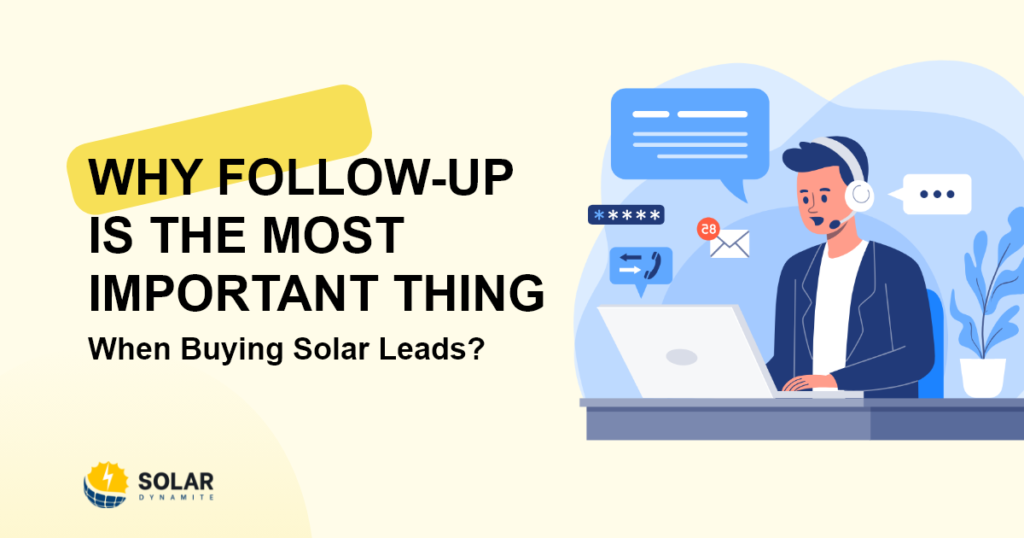Buying solar leads would not be sufficient if you didn’t know the art of following up, one of the most crucial marketing strategies to turn prospects into paying customers.
A report by IRC Sales Solutions says only 2% of leads convert into final sales after the first point of contact. But the percentage goes up by 80 after the fifth to twelfth point of contact. However, due to the fear of rejection, 44% of salespeople give up only after the first attempt and miss out on 98% of potential revenue.
This is why it is important for solar business owners to master the technique of follow-up. It will specifically give a leg to your competitors when you both have shared leads.
Always remember,
customers would like to go for companies that are committed to them and are there for them round the clock. For them, their needs should be the top priority, and everything else should come second.
However, it is easier said than done. There is a thin line between a subtle follow-up and being pushy. Crossing that border can take that quality solar lead away from you forever.
Having said that, let’s dive into the significance of follow-up when buying solar leads in more detail and the ways to do it successfully.
Table of Contents
Why perform a solar lead followup?
Buying solar leads can only help you make the first point of contact with the prospective buyer. But how you convert it into a sale is totally dependent on how well you nurture them, build trust, and convince them to go with your solar services. A majority of solar companies (especially startups) lack at this point and miss the opportunities.
Check out these best CRM solutions for solar companies to manage their real-time sales projects.
Following are the reasons why people don’t buy a particular product or service:
- Occupied with too many options on their mind.
- Lack of time and energy.
- Financial constraints.
- Other pressing matters.
- The failure of a company to establish a name in the market raises doubts about their offerings.
However, it is imperative to understand that none of the aforementioned reasons are personal. They are only psychological factors. That is where the role of sales follow-up becomes so important.
Below are the key benefits of consistent solar lead follow-ups in the sales process:
Builds long-term relationships
A lead follow-up gives you a fair chance to present your brand to the potential solar prospects so that they can know about your company’s mission and vision. By following up in the right way, you can let them know how much you, as a solar installer, understand and care about their needs. And we are ready to fulfill their requirements with your high-quality services. All these help in building a sense of trust among them and thus lay the foundation of a fruitful relationship for the long run.
Addresses their pain points
A business is all about how well you resolve the customers’ problems. By leading follow-ups with one-on-one conversations, you eliminate the likelihood of any miscommunication and can directly ask and address their actual pain points. For instance, some customers might be taking a step back due to higher panel installation costs, or they might be confused by the ample number of options. In such cases, take your brand services forward to the solar prospects and help them come up with the best possible solutions to their problems.
Gauging interest
One of the prominent benefits of lead follow-up is letting solar businesses know how interesting their brand seems in the eyes of potential customers. Based on these metrics, a brand can work on their solar marketing strategies, if needed, to seem more captivating, engaging with more clear goals in front of their solar prospects.
Maximizes the rate of conversions
Taking consistent solar lead follow-ups helps you maximize conversion rates. This ensures that every single lead you have ever interacted with or engaged with, either through a call, text, website, or any marketing channel, does not slip due to your lack of awareness. All you need to do is show tenacity. Research shows that salespeople who have gone through a minimum of five follow-ups have resulted in closing the deal.
To further boost your lead generation process, read SEO for Solar Companies.
Practices to successfully take the solar lead follow-up

Employ a variety of follow-up techniques
For some customers, text is the preferred method for contacting them, while for others, a call is the most suitable, and some would like to get contacted via email. This is why it is important to employ a combination of all of them and see which makes you more lucky. Let’s dig a little deeper into each of these methods:
Text
For the solar leads who would like to contact over text, always show a more thoroughness by asking, Where can I text you? This will start the conversation organically by not being too pushy. However, this method has its own set of disadvantages. One, the customer won’t be able to sense your tone. Two, they can exit the conversation by not responding to them. Nonetheless, you can always bridge this gap by using the right emojis and neutralizing your tone.
Call
Chances are your prospective lead might be busy on call with someone while you are trying to contact them on the other side. Or they might not even respond to you. But don’t get disheartened. Research says 48% of lead follow-ups taken over phone calls never make it to the first time. So, take a 1-2 day break and re-contact them. However, don’t forget to leave a voice call. Anyway, a missed call from an unknown number left in the customer’s phone is not going to make anything useful to you.
Email marketing may not be the first preferred choice for a point of contact, but it is still necessary. You need to utilize every single follow-up channel to convert more and more solar leads into paying clients. But that does not mean we are promoting someone’s spam folder with countless emails. As long as you take it in a healthy manner, keep contacting them at regular intervals. Research says the initial rate of an email is nearly 6%; however, if taken correctly, it could increase the response rate by 8.5% just after a single follow-up.
In short, you need to mold your strategy according to the client’s preferences. It would make zero sense if you were trying to get business over text, whose preferred mode of communication is call or email.
Don’t be pushy
The quickest way you can annoy your solar leads is by contacting them repeatedly through different channels. This would make them feel as if you were intruding on their privacy.
You need to understand that purchasing decisions take time, and it could extend if that service holds a sizable value. Thus, you can’t expect the results overnight and have to be patient throughout the follow-ups.
And if you ask, How much space or time should you give to your solar prospects? then there is no defined answer. It entirely depends on the buyer’s mindset and their personal time frame.
However, Harvard research says that Wednesday and Thursday are the two good days to take follow-ups. Mondays can be too busy for everyone, and Fridays can be too slow due to all the winding up. And the best time would be between 3:30 and 5 p.m.
Also, another theory states that taking a week off is also good for taking the next follow-up while also not annoying them.
Make every follow-up count
The next way you can maximize your solar lead conversions is by giving insightful information in each of your solar lead follow-ups. The end goal should always be to resolve the customer’s doubts or questions and not convert them into leads. Of course, that is what all these efforts are for, but we guess you got our point.
Make sure, while you are having a conversation with them, your pitch is friendly and supportive. Ideally, you should remember one key thing about each potential buyer.
For instance, let’s assume your future client told you the last time you had a chat that they are looking for more solar panel installation services and could also provide roofing services at a competitive price. You can initiate the conversation by saying that this time your company has launched some packages that will fulfill their requirements. This way, people will find this point interesting and will engage with you further.
Next, assure that you remember all their pain points, and with this follow-up, you are coming up with solutions for them. You can even offer them the limited-period discount on solar services. This would again grab their attention.
Overall, in order to convert and generate the revenue, keep in mind that every follow-up ends up providing some value to them, either financially or informatively.
Follow the rule of five “nos” follow-ups
According to the studies conducted by different companies over different periods of time at different places, 80% of sales happen only after a minimum of five follow-ups. Below are some additional stats related to this:
- 44% of salespeople give up after the first attempt.
- 22% of salespeople give up after the second attempt.
- 14% of salespeople give up after the third attempt.
- 12% of salespeople give up after the fourth attempt.
This means the 8% of people who take the follow-ups up to 5 or more attempts are the ones who get the profits of 80% sales. This implies that in order to convert your buying solar leads into final conversions, you also need to go through the minimum of five follow-ups with prospects until each of them has answered no, not now or may be later.
Always remember that every single point of contact gives you an opportunity to build a healthy relationship between your brand and the potential solar buyer.
Keep it brief and simple
Bear in mind that your solar leads are always busy. They don’t have time for hours of conversation over chat, call, email, or recurrent meetings. So, cut to the chase and keep your follow-ups crisp, brief, and simple.
For instance, if you are taking follow-up over email, then personalize your subject line and create a sense of urgency in your description. This would increase the open rates by 29%, as per a study.
If you are considering follow-up over a phone call, the log time should not exceed more than 10 minutes.
And if text is the mode of communication, again, keep it to the point.
We guess we are not suggesting too much to implement. Do we? That’s because we are making it very clear from the beginning that your prospects only have a couple of minutes or a fraction of seconds to engage with you. Make that time count.
Final Words: Don’t be afraid of follow-ups when buying solar leads
Taking consistent follow-ups is the soul of any fruitful marketing strategy, and solar business is no longer the exception. Many salespeople usually get afraid to take the next step, mostly because of the fear of rejection, seeing themselves as an annoyed person in the prospects’ eyes, or being projected as a spammer and missing out on the potential sale.
By not taking follow-up, you are clearly losing out on the 80% potential sale, a significant loss in overall revenue.
Therefore, don’t be. Consider it a part of your sales funnel. When you hear a clear no from a solar prospect, take it positively. This simply means that either you would be crossing off that lead from your checklist and moving on with the next or you would be meeting the end-user requirements.
In case you feel overwhelmed with this whole follow-up journey, we would recommend taking a break, reframing your mind, and starting fresh.




